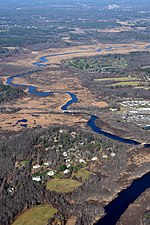Egg Rock

Egg Rock is an outcrop of Silurian Straw Hollow Diorite at the confluence of the Assabet and Sudbury rivers, where they form the Concord River in Concord, Massachusetts. The outcrop is located on a roughly oval intermittent island of about 100 by 50 meters. Egg Rock is usually accessible using foot trails over land, but during high river levels the island is separated from the mainland by a narrow channel. The highest point of Egg Rock is about 39 meters above mean sea level and about 6 meters above normal river level. The United States Geological Survey (USGS) Geographic Names Information System (GNIS) includes Egg Rock as GNIS feature 617309, classified as an island. In the GNIS database as of February 2010, the listed position (latitude 42.4645383, longitude -71.3592266) is misplaced by about 125 meters to the southwest, and is not actually located on the intermittent island. A more correct position is latitude 42.4651, longitude -71.3585.
Excerpt from the Wikipedia article Egg Rock (License: CC BY-SA 3.0, Authors, Images).Egg Rock
Calf Pasture Trail (yellow dot),
Geographical coordinates (GPS) Address Nearby Places Show on map
Geographical coordinates (GPS)
| Latitude | Longitude |
|---|---|
| N 42.4651 ° | E -71.3585 ° |
Address
Egg Rock Land
Calf Pasture Trail (yellow dot)
01742
Massachusetts, United States
Open on Google Maps











